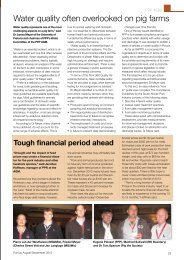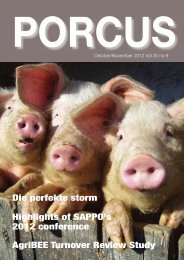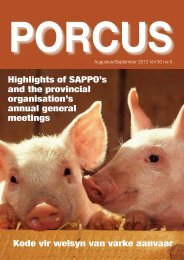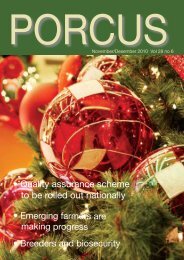porcus - sappo
porcus - sappo
porcus - sappo
Create successful ePaper yourself
Turn your PDF publications into a flip-book with our unique Google optimized e-Paper software.
34<br />
nutrition<br />
Mycotoxins Continued from p 33<br />
intoxication with T-2 toxin may be a consequence<br />
of shock syndrome with reduced<br />
cardiac output and hypotension.<br />
Similar to DON, Type A trichothecenes<br />
can also reduce feed intake via altered<br />
brain neurochemistry.<br />
Swine fed 5 to 10 ppm T-2 toxin displayed<br />
reduced feed intake and weight<br />
gain while complete feed refusal was<br />
observed at 16 ppm. Growing swine<br />
fed T-2 toxin became soporific and<br />
developed dermatitis and crusting of the<br />
skin on the snout, nose, oral commissure,<br />
ears and prepuce. Gastrointestinal<br />
hemorrhagic syndrome has been associated<br />
with natural trichothecenes feed<br />
contamination in beef cattle and swine.<br />
The specific T-2<br />
toxin induced oral lesions serve as an<br />
indicator of possible diet contamination<br />
with Fusarium toxins. Trichothecene A<br />
mycotoxins-induced immune suppression<br />
affects all the components of the<br />
immune system (inflammation, humoral<br />
and cell-mediated responses).<br />
Feeding swine 0.5 to 3 ppm T-2 toxin<br />
for 21 days reduced specific antibody<br />
levels to horse globulin and peripheral<br />
blood mononuclear cells stimulation.<br />
Type B trichothecene Fusarium<br />
mycotoxins<br />
The major mycotoxin belonging to this<br />
group is DON and it is generally considered<br />
as a marker for the presence of<br />
other Fusarium mycotoxins. Pig is the<br />
most sensitive domestic animal species<br />
to DON and DON-induced feed refusal<br />
and the subsequent growth depression<br />
has been causing major economic<br />
losses globally.<br />
The effect of DON in reducing feed intake<br />
has been related to elevated blood<br />
tryptophan and brain serotonin concentrations.<br />
DON is usually accompanied by<br />
fusaric acid as a co-contaminant and the<br />
loss of appetite is greater when they are<br />
present together.<br />
Pair-feeding studies in pigs have<br />
shown that feed refusal can explain<br />
most of the growth depression observed<br />
in pigs exposed to DON. When fed at<br />
low levels, however, pigs can consume<br />
DON-contaminated feed and may be<br />
exposed to its direct immunosuppressive<br />
effects.<br />
Monocytes, macrophages, as well as<br />
T- and B-lymphocytes of the immune<br />
system can be cellular targets of DON<br />
and other trichothecenes. A great deal of<br />
research has been conducted on DON-<br />
induced IgA nephropathy in mice and<br />
elevated serum IgA concentrations have<br />
been noted in pigs. Feeding of up to 4.7<br />
ppm DON for nine weeks to growing<br />
pigs resulted in dose-dependent reduction<br />
in secondary antibody response to<br />
tetanus toxoid. Feeding DON-contaminated<br />
grains can increase the incidence<br />
of stillborn piglets in gilts. Sows fed the<br />
same contaminated grains exhibited<br />
reduced feed intake, weight loss, lower<br />
serum protein and urea concentrations,<br />
and tendency for increased weaning to<br />
oestrus interval.<br />
Fumonisins<br />
Six different fumonisins (A 1 , A 2 , B 1 , B 2 ,<br />
B 3 and B 4 ) so far have been isolated and<br />
their mechanism of action appears to<br />
be a disruption of sphingolipids synthesis<br />
in biological membranes. Although<br />
fumonisins toxicity in swine is characterised<br />
by pulmonary oedema, their effects<br />
on swine immunity seem to be of major<br />
commercial significance.<br />
In spite of discrepancy in the literature<br />
related to the concentration of fumonisins<br />
required to cause chronic toxicity in<br />
pigs, Rotter and others (1996) showed<br />
11% decrease in weight gain when<br />
10 000 ppb FB 1 was fed to starter pigs.<br />
It is important to note that this level of<br />
fumonisin or even higher is very common<br />
in swine feeds as in some countries<br />
(such as USA) more than 50% of swine<br />
diets may contain corn.<br />
Bouhet and Oswald (2007) recently<br />
reviewed the impact of fumonisin ingestion<br />
on the intestine. Fumonisins can<br />
alter intestinal epithelial cell viability and<br />
proliferation, modify cytokine production,<br />
and modulate intestinal physical<br />
barrier function. All these effects may<br />
lead to reduced nutrient absorption<br />
and/or increased disease susceptibility.<br />
Research from del Rio Garcia and others<br />
(2007) also concluded that the combination<br />
of aflatoxins and fumonisins at low<br />
concentrations can produce synergistic<br />
effects on altering the intestinal cellular<br />
morphophysiology. FB 1 can also alter the<br />
cytokine profile and decrease the specific<br />
antibody response to vaccines.<br />
Zearalenone<br />
This is a very common Fusarium fungal<br />
metabolite and often found in association<br />
with either DON or nivalenol. Pigs<br />
are very sensitive to zearalenoneinduced<br />
oestrogenic syndrome which is characterised<br />
by reddening and increased size<br />
of vulva, increased size of mammary tissue,<br />
abnormal lactation, infertility, pseu-<br />
dopregnancy, still births, abortions and<br />
rectal or vaginal prolapses. It has been<br />
recommended that 0.5 ppm zearalenone<br />
would have no serious effects on the<br />
reproductive efficiency of young gilts.<br />
This recommendation, however, needs a<br />
revisit as more information is now available<br />
on the previously described masked<br />
zearalenone. Unlike the reproductive<br />
function, growth performance in pigs is<br />
less affected by zearalenone and further<br />
research is needed to define its impact<br />
of on the immune system.<br />
Ergot alkaloids<br />
Ergotism is the disease caused by the<br />
ingestion of alkaloids contained in the<br />
sclerotia of Claviceps species. There are<br />
several ergot alkaloids detected in<br />
grains (sorghum, wheat, barley, oat and<br />
rye) used for swine feed and these<br />
are pharmacologically active compounds.<br />
The effect of feeding ergotcontaminated<br />
grain to pigs is not consistent,<br />
and ultimately depends on both the<br />
ergot content and the alkaloid concentration.<br />
Murphy (2006) suggested that the<br />
maximum tolerable ergot level in the diet<br />
was 0.10 and 0.05% based on average<br />
daily gain and average daily feed intake,<br />
respectively, corresponding to 2.07 mg<br />
and 1.04 mg alkaloid/kg diet. Increased<br />
intake of ergot-contaminated feed can<br />
cause a severe reduction in the growth<br />
performance of weaned pigs with or<br />
without an effect on feed intake.<br />
Ergot alkaloids can affect the reproduction<br />
of sows through the effects on<br />
prolactin levels. Because of the wide biological<br />
variation in both the quantity and<br />
quality of the alkaloids present in ergot<br />
sclerotia, it is very difficult to establish<br />
safe levels.<br />
Mycotoxin interactions in pigs<br />
Mycotoxins seldom occur in isolation<br />
in poultry feeds. Mycotoxins discussed<br />
above and many more occur together<br />
and by no means do the mycotoxins<br />
discussed above form a complete list.<br />
This co-occurrence makes the individual<br />
mycotoxin tolerance dose irrelevant (safe<br />
levels) and therefore, the mere presence<br />
of multiple mycotoxins in swine feed<br />
should be considered as a warrant.<br />
Mycotoxin interactions within the body<br />
of pigs are very well proven. These interactions<br />
are mainly additive in nature, but<br />
can be synergistic antagonistic as well. It<br />
is important to note that the type of interaction<br />
can vary for different parameters<br />
in the same animals.<br />
Porcus Januarie/Februarie 2012







